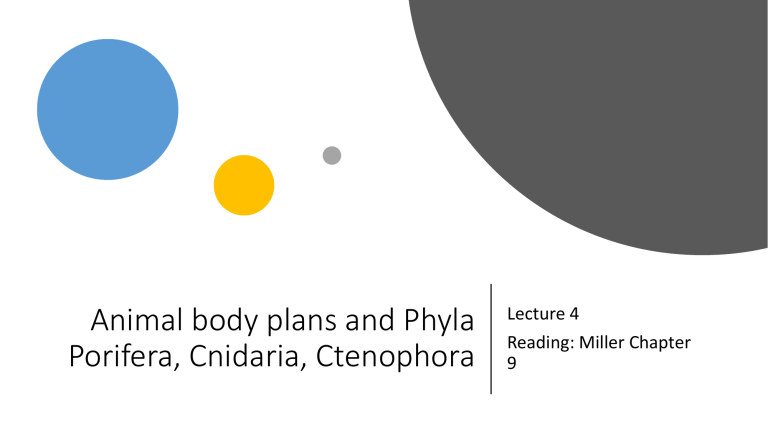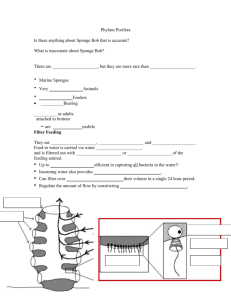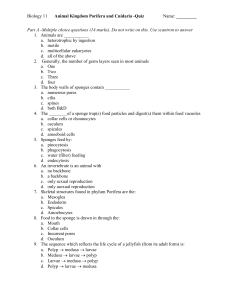
Animal body plans and Phyla
Porifera, Cnidaria, Ctenophora
Lecture 4
Reading: Miller Chapter
9
How Did Animals Get Here? A
Few Theories…
Today We Will
Examine
What is a Porifera?
What is a Cinidaria?
What is a Ctenophore?
Colonial hypothesis: dividing
cells of an early protist
stayed together
Origins of
multicellularity
Syncytial hypothesis:
formation of a plasma
membrane in the cytosplasm
of an early syncytial protist
Phylum Porifera
(sponges)
• Primarily marine
animals
• 9000 species
worldwide
Phylum Porifera
• Characteristics:
• Loosely organized cells
but lack true tissues
• Lack symmetry
• No circulation or nervous
system
• Lack cephalization (no
head)
• Most reproduce sexually
and asexually
Spicules: provide
structural support
Incurrent Canal
Porifera body
plans
Figure 9.6 Sponge Body Forms in more detail.
Ascon: simplest, thin
walls, tube shaped
Sycon: thicker,
folded body wall
Leucon: largest,
most complex
• Complex sponges have increased surface area for choanocytes
which results in filtering large volumes of water.
• Pinacocytes: Line
the outer surface,
mildly contractile
Cell Types, Body Wall and
Skeletons
• Porocytes:
specialized
pinacocytes that
help regulate
water circulation
Cell Types Body Wall, and
Skeletons
• Mesohyl (middle spongy
layer)
• Mesenchyme cells :
these cells move about
in the middle layer and
• 1. perform
reproductive
functions
• 2. secrete skeletal
elements
• 3. transport and
store food
• 4. form contractile
rings around the
opening
Cell Types, Body
Walls, and Skeletons
• Choanocytes
• Collar cells that
are flagellated
• Create water
currents through
the sponge
Cell Types, Body Walls, and
Skeletons
• The skeleton of sponges may be formed
in one of two ways:
• 1. Spongin- fibrous protein made of
collagen. These fibers give the sponge its
shape and keep it from collapsing
spongin
• 2. Spicules – made of calcium carbonate
or silica
Water Current and Body Forms
Class Demospongiae
Examples of
porifera
Class Hexactinellida
Class Calcarea
• Freshwater Demospongiae
Porifera
• Feed on algae, protists,
bacteria and suspended
organic matter
• A single sponge can filter 20
liters of water a day (10
gallons)
• No lungs- gas exchange via
diffusion
• Most have only 1 sex but do
not self-fertilize
Ecology
• Reduce turbidity of coastal waters
• A few are carnivorous
• Many have photosynthesizing
endosymbionts (photosynthetic organisms
that live within sponge)
• Food for turtles, fishes, ducks, crayfish,
sponge flies
• Habitat for symbionts: e.g., shrimp, feed
off particles that collect on sponge
• Human uses: bathing, washing, cosmetics
Sponge
Reproduction
Pause and
Reflect
• What is a sponge?
• Why are they
important?
• Why are they an
important link between
unicellular and
multicellular animals?
• How do they
reproduce?
Phylum Cnidaria
• Cnidarians (jellies, anemones,
corals, hydra)
• Diploblastic (2 germ layers)
• Radial symmetry
• Not cephalized (no head)
• Simple nervous system (nerve
net)
• Specialized cells, called
cnidocytes, used in defense,
feeding, and attachment
Tissues
• Hydrostatic
skeleton: Water
confined within
grastrovascular
cavity creates
hydrostatic
compartment
• Provide support
and aid body
movement
Figure 9.8
Body wall of a
cnidarian
(Hydra).
Cnidae
• Zoologists have described
nearly 30 types
• Some cnidae contain
unarmed tubes that
wrap around prey
• Some cnidae help
anchor the animal
• Nematocysts used in
food gathering and
defense
• Spines have
hollow tips and
deliver
paralyzing toxins
• Animals may have 6+
kinds of cnidae in one
individual
Nerves and
Movement
Cnidarian Body Forms
Alternation of
Generations
• Many cnidarians possess two body forms in
their life histories
• Polyp – asexual and sessile
• Cylindrical body
• Mouth surrounded by food gathering
tentacles
• Budding produces miniature medusae
• Medusa – dioecious and free swimming
• Shaped like inverted bowl
• Tentacles hang from free margins
• Swims with gentle pulsations
Reproduction:
Alternation of Generations
Cnidarian
Life Cycle
Classification
Pause and
Reflect
• What is a Cnidarian
• How are they different
from sponges
• Why are they
important
• How many Classes of
Cnidarians exist?
Hydrozoa
Obelia
Hydra
Gonionemus
Characteristics:
*External
Nematocysts
*Epidermal gametes
*Acellular mesoglea
Portugese Man O’War
Man of War
Staurozoa
• *Goblet-Shaped
• *8 sets of
• tentacles
• *Limited dispersal
• *lack medusa
stage
Scyphozoa: “True
Jellyfish”
• *Mesoglea with
amoeboid cells
• *Cnidocytes also in
gastrovascular Cavity
• * Dominant stage in life
history is medusa
Anthozoa: Corals and
Anemones
Marine, lack medusae
•Has a pharynx
•Divided gastrovascular
Cavity
•*
Anthozoan life
cycle….
Cubozoa: “Cube
Jellyfish”
•*Polyp stage very small
or unknown
•*Medusa cube-shaped
•*Tentacles at corners
•*Some dangerous!
Cellular mesoglea and true muscle cells suggest that
members may be triploblastic.
Locomotion by bands of fused cilia are called comb
rows
Phylum
Ctenophora:
comb jellies
Tentacles contain adhesive cells called colloblasts that
capture prey
Biradial symmetry
Gelatinous, cellular mesoglea
Monoecious with
gastrodermal gonads
External fertilization leads
to flattened larval stage.
Figure 9.22 Phylum Ctenophora.
Copyright © 2016 McGraw-Hill Education. All rights
reserved. No reproduction or distribution without the
prior written consent of McGraw-Hill Education
Phylum Ctenophora
Sea Walnuts/Comb Jellies
Coral Reefs
Local and Global Pressures Threaten Coral Reefs
Questions?





